Ultrasound triage of women with postmenopausal bleeding
Ultrasound-based evaluation is less costly than an endometrial biopsy and also allows for evaluation of the adnexa and bladder.
Dr. Shwayder is Professor and Chairman, Department of Obstetrics and Gynecology, University of Mississippi Medical Center, Jackson.
He reports receiving royalties from Cook Medical for the Goldstein SonoBiopsy Catheter.
Endometrial cancer is the most common gynecologic cancer in the United States. In 2014, an estimated 52,630 new cases will be diagnosed, with 8590 women dying from cancer of the uterine body and uterine sarcomas comprising approximately 2% of uterine cancers.1 Approximately 3 out of 4 cases are diagnosed in women aged 55 years and older. Ninety percent of postmenopausal patients with endometrial cancer present with vaginal bleeding.2 Conversely, up to 14% of patients who present with postmenopausal bleeding (PMB)-defined as an episode of bleeding 12 months after the last menstrual period-will have endometrial cancer.3,4 These patients require timely and efficient evaluation.
Endometrial evaluation
Historically, the routine evaluation of PMB was by dilatation and curettage (D&C) performed in an operating environment. Evaluation then progressed to the office, first with the Vabra aspirator (1970s), then the Novak curette (1980s), and ultimately (in the 1990s) the suction-piston biopsy instrument, commonly known as a Pipelle endometrial suction curette. The Pipelle reportedly detected almost 98% of endometrial cancers.5 However, subsequent studies have found that the sensitivity of detecting endometrial cancer with Pipelle endometrial sampling ranges from 83% to 98%.6,7
Two studies highlight the limitations of a blind Pipelle endometrial sample. Rodriguez et al. compared the surface area sampled by a Vabra aspirator and a Pipelle endometrial sampler in 25 patients scheduled for hysterectomy.8 The Vabra aspirator sampled 41.6% of the endometrium, while the Pipelle device sampled only 4.2%. Guido et al. performed Pipelle endometrial sampling prior to hysterectomy in 65 patients with known endometrial cancer.6 Pipelle sampling missed the cancer in 11 of 65, or 17% of patients. The cancer involved less than 50% of the cavity surface in all patients with a missed diagnosis. In 4 patients, less than 25% of the surface area was involved, while less than 5% was involved in 3 patients. Pipelle sampling missed 5 cancers confined to polyps. Since endometrial cancer can be a focal rather than global disease, blind sampling is prone to error. In addition, sampling failure, defined as an inadequate sample or inability to perform a biopsy, can be as high as 54%.9 In patients with tissue insufficient for diagnosis (TIFD) the incidence of significant endometrial disease was 20%, with endometrial cancer found in 3% of patients.10
TVS and endometrial thickness
Transvaginal sonography (TVS) gained popularity for evaluating PMB in the early 1990s due to its ready office availability and its value in ruling out significant endometrial disease.11,12 Initial studies indicated that an endometrial thickness >5 mm would identify 96% of endometrial cancers.3 Conversely, an endometrial thickness ≤5 mm was associated with a 4% chance of endometrial cancer.3 The negative predictive value of a thin endometrium was quite good. Initial recommendations required no additional evaluation if the endometrium was ≤5 mm in double-layer thickness.2
Subsequent studies evaluated the merit of even thinner thresholds for further evaluation. Gupta et al. determined that the probability of endometrial cancer was reduced the thinner the endometrium on initial evaluation: 5 mm = 2.3%; 4 mm = 1.2%; and 3 mm = 0.4%.13 Timmermans et al. also found that decreasing the threshold endometrial thickness improved cancer detection, with sensitivities of 90% at 5 mm, 95% at 4 mm, and 98% at 3 mm.14 They recommended decreasing the cutoff for excluding endometrial cancer to 3 mm. Clearly, decreasing the thickness that prompts further endometrial evaluation increases the sensitivity but decreases the specificity of TVS. Most studies recognize that a threshold endometrial thickness >4 mm adequately screens for >98% of endometrial cancers.15
ACOG recommendation
In August 2009, American College of Obstetricians and Gynecologists (ACOG) Committee Opinion Number 440 elucidated the role of ultrasound (U/S) in evaluating postmenopausal bleeding.16 This opinion recommends either vaginal U/S or an endometrial biopsy in the initial evaluation of patients with postmenopausal bleeding. The presence of a thin, distinct endometrial echo ≤4 mm is associated with a risk of malignancy of 1 in 917. Thus, further endometrial evaluation is not required. An endometrial biopsy is technically possible in 82% of patients with endometrial thickness <5 mm, but a sample adequate for diagnosis is obtained in only 27%.16U/S is a screening tool used to identify those patients with a low risk of cancer who do not require further evaluation at the initial assessment.
If an endometrial biopsy is performed initially and reveals TIFD, it cannot be relied upon to eliminate significant endometrial disease (Figure 1). Patients with TIFD require further evaluation,4 which can be done with TVS. If TVS demonstrates the endometrium is <4 mm, the initial evaluation is complete. If the endometrium is >4 mm, further endometrial evaluation is recommended with saline infusion sonohysterography (SIS) or hysteroscopy.
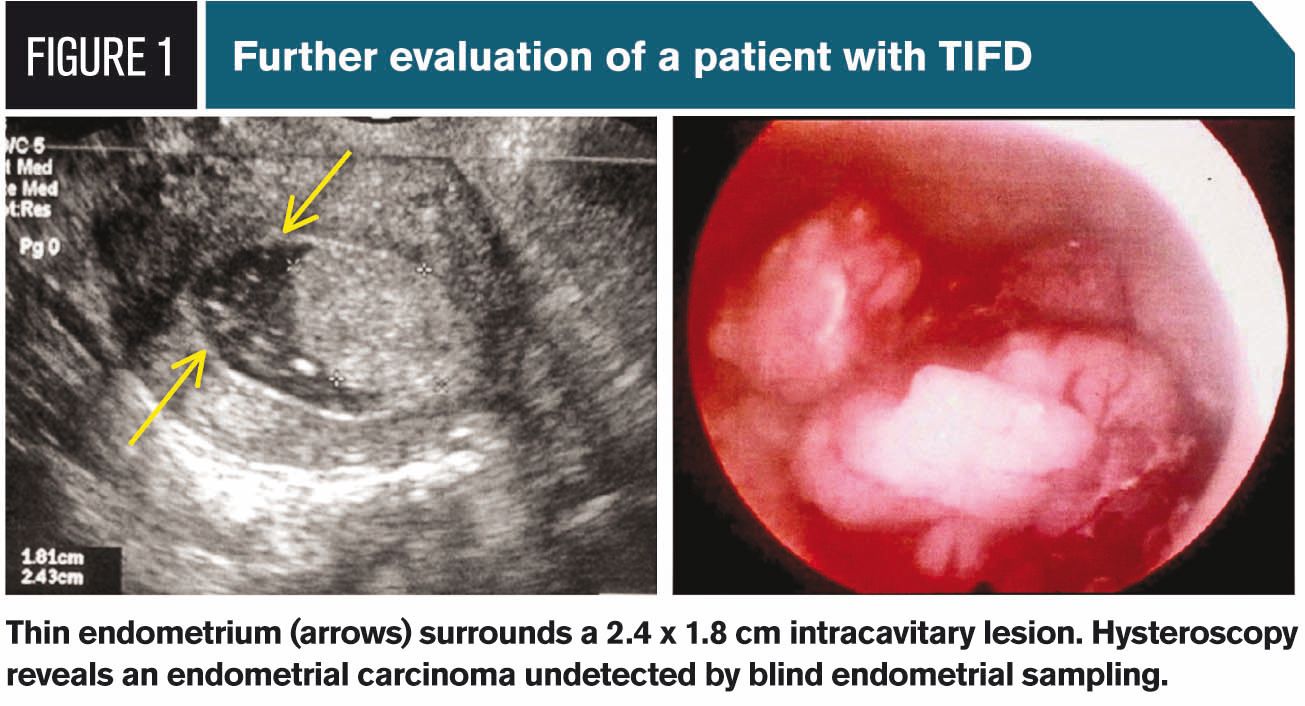
Recurrent bleeding after initial evaluation
Some clinicians are reluctant to rely on U/S without having a tissue diagnosis. A 2003 report by Gull et al. offers guidance.17 This study evaluated 339 patients with TVS and endometrial sampling 10 years after an initial benign evaluation with TVS and D&C for PMB. None of the patients without bleeding during the 10-year period was found to have endometrial cancer. In contrast, 11.5% of patients with recurrent bleeding were found to have cancer.17 Thus, cancer is highly unlikely if the endometrial thickness on the initial U/S is <4 mm and the patient has no recurrent bleeding. However, recurrent bleeding requires further evaluation with endometrial sampling, at a minimum, preferably in combination with SIS or hysteroscopy.
Technical aspects of measuring the endometrial echo
U/S can be performed at any time in postmenopausal patients on no hormone therapy or on continuous combined therapy. Patients on cyclical hormonal therapy should have the U/S performed shortly after their bleeding episode. The endometrial thickness, also called the endometrial echo complex (EEC), should be measured only in the sagittal or longitudinal midplane view. To be reliable, the EEC should be visualized from the endocervical canal to the fundus (Figure 2). Many clinicians feel compelled to measure any white, linear area and deem it the endometrial echo. This leads to unreliable results. If the endometrium cannot be seen in its entirety, which occurs in more than 10% of cases,18 the clinician should state that the endometrium is “not well visualized” or “indistinct” and recommend further evaluation, such as SIS or hysteroscopy. When the EEC is adequately visualized, both layers of the endometrium should be measured together to arrive at the endometrial thickness. When identifying fluid within the endometrial cavity, each layer of endometrium should be measured separately and added together for the total endometrial thickness (Figure 3). Early reports about fluid within the endometrium raised concerns for cancer of the ovary, fallopian tube, cervix, or endometrium.19 More recent reports indicate that most patients (84%) have atrophic endometrium, with the fluid collection likely due to some degree of cervical stenosis.20,21
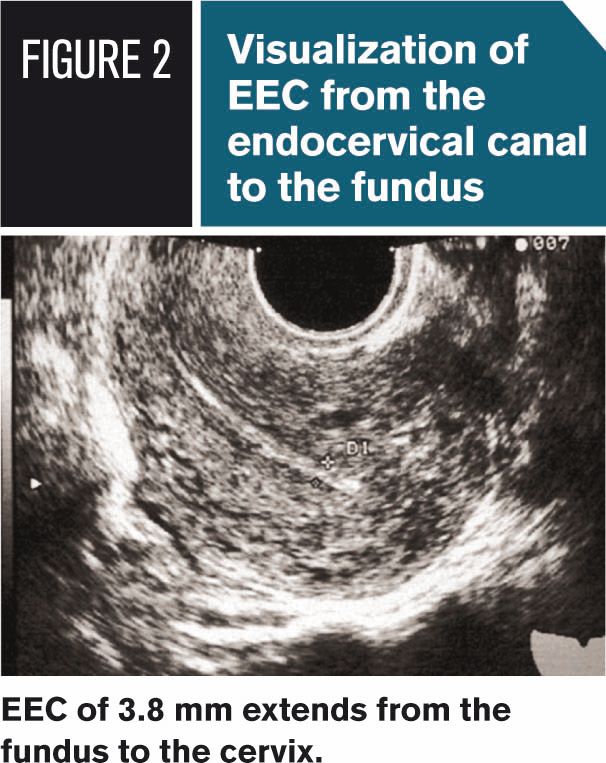
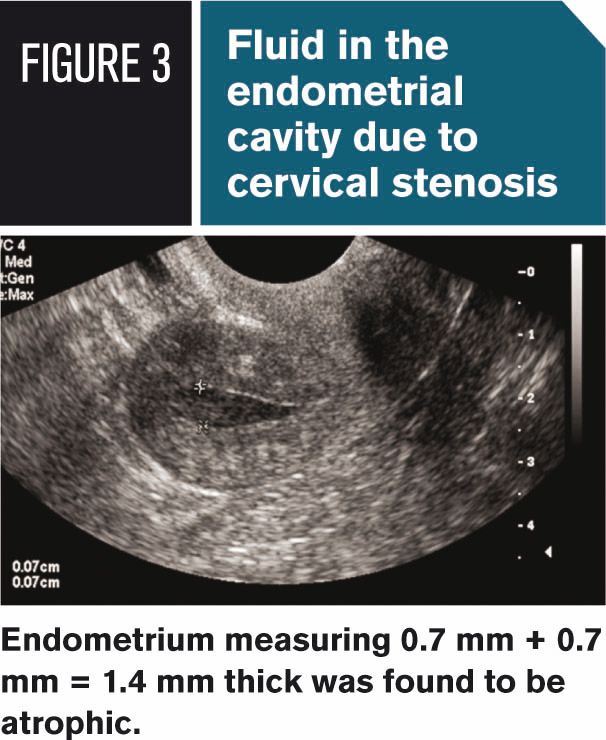
Doppler at the time of TVS
Color flow and power Doppler imaging enhances the ability to diagnose endometrial polyps. The presence of a central vessel in the EEC is highly predictive of an endometrial polyp (Figure 4). Amit et al. studied 60 women with PMB and found that power Doppler had a sensitivity of 86% and a specificity of 89% in detecting endometrial polyps.22 SIS can confirm this finding and help plan for surgical removal.
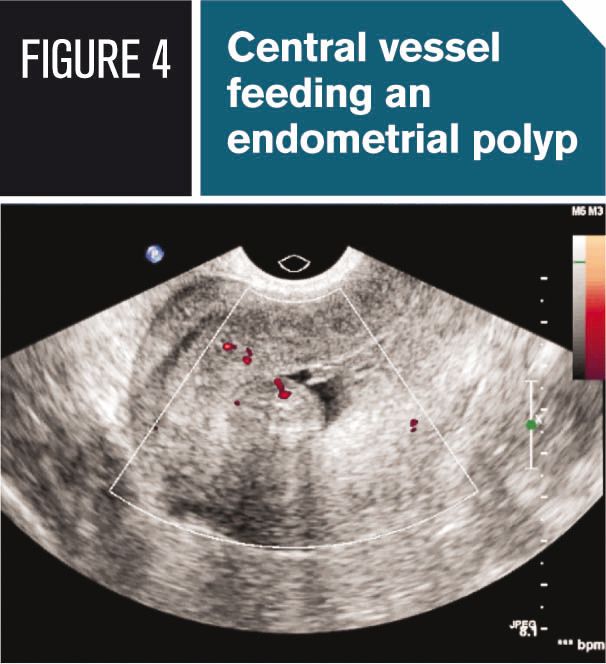
Advantages of U/S-based triage
Cost
Two studies, one in the Netherlands and one in the United States, determined that U/S-based evaluation was less costly than initial evaluation with an endometrial biopsy.23,24 Dijkhuizen et al. concluded that a strategy starting with endometrial biopsy was most cost-effective when the prevalence of endometrial cancer was >15.3%.23 TVS combined with biopsy was the most cost-effective strategy in cases in which the endometrial thickness was >9 mm.
Weber et al. also concluded that vaginal U/S was more cost-effective than endometrial biopsy as the initial diagnostic test.24 This was based on a $72 cost for TVS and a cost for endometrial biopsy, including processing and interpretation, of $200. Using TVS resulted in a cost savings of $14 to $20 per patient. This analysis was based on cost, not charges. Charges could well affect this analysis and change the authors’ overall conclusion.
Adnexal evaluation
Vaginal U/S has the added advantage over hysteroscopy of allowing evaluation of adjacent organs including the ovaries and bladder. Gupta et al. compared Pipelle and TVS performed prior to hysteroscopy and curettage in evaluating 76 patients with PMB.25 They found that TVS was more sensitive and specific than Pipelle sampling in diagnosing endometrial abnormalities (83% and 77% vs 70% and 70%, respectively). In addition, 5 ovarian masses were detected on TVS: 3 that were missed on pelvic exam and 2 that were malignant. Thus, 2.6% (2 of 76) of patients presenting with PMB were found to have ovarian cancer. The significance of this study is illustrated by the case of a 61-yearold patient presenting with spotting for 2 months. Office hysteroscopy revealed atrophic endometrium, which was confirmed on biopsy (Figure 5). She then had a TVS that revealed a 3.5-mm endometrium, consistent with the hysteroscopic findings. However, she was found to have a 4.67-cm left ovarian mass that was a papillary cystadenocarcinoma (Figure 5).
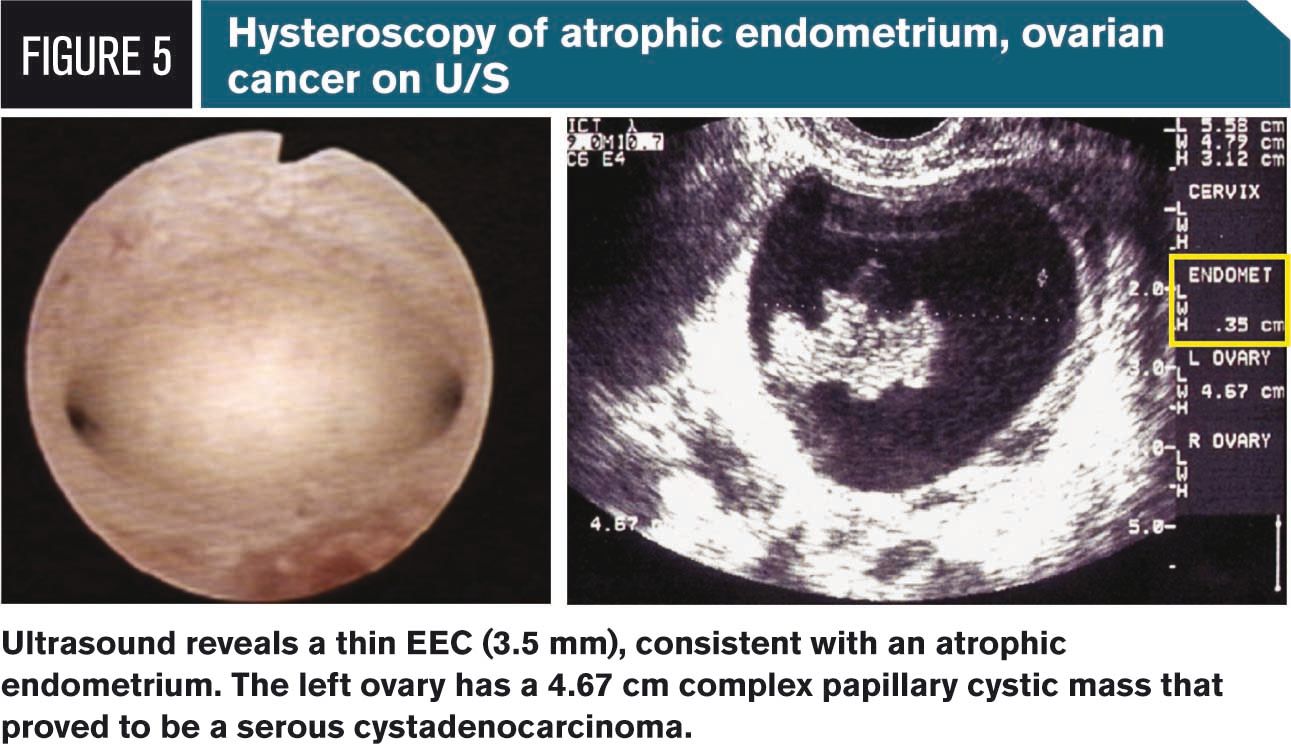
Bladder evaluation
TVS also allows evaluation of the bladder. A representative case is that of a 70-year-old presenting with PMB. This patient was referred for a SIS. Her initial TVS revealed a 2.0-mm endometrial thickness, which was confirmed on SIS with a 1.9-mm bilayer thickness (Figure 6). Her endometrial biopsy revealed atrophic findings. However, a cystic mass was found in the base of the bladder with adjacent wall thickening (Figure 6), which proved to be a ureteral cyst with transitional cell carcinoma of the bladder. These cases illustrate the additional advantages of TVS over hysteroscopy and endometrial biopsy. The ability to assess adjacent organs separates TVS from the other technologies.
Type I versus II endometrial cancer
Conventional understanding holds that a thin EEC does not exclude type II endometrial cancers.26 Type II cancers include endometrioid adenocarcinomas, serous adenocarcinomas, clear cell adenocarcinomas, and mixed adenocarcinomas, which all have a poor prognosis.27 A report by Hosoi et al. found that the endometrium was >4 mm in 89% of type I endometrial cancers and 93% of type II cancers, a difference that was not statistically significant.27 This report concluded that the “4-mm (5-mm) rule” was applicable even with type II cancers.
Sonohysterography
Sonohysterography offers an excellent alternative to hysteroscopy in diagnosing endometrial abnormalities. It is indicated when patients are found to have an indistinct or thickened endometrium (Figure 7). SIS is readily available in any office with TVS capabilities, requiring only a suitable catheter and saline for infusion. Infusing saline distends the endometrial cavity, demonstrates intracavitary focal lesions, and delineates each layer of the endometrium. Epstein et al. evaluated 105 women with postmenopausal bleeding with TVS, SIS, and hysteroscopy.28 They found 96% agreement between SIS and hysteroscopy in identifying endometrial polyps and submucous myomas, both with 80% sensitivity.28 Of interest, they also found a 7-fold greater risk of malignancy (odds ratio 7.3) in patients whose cavities were difficult to distend at SIS. Ultimately, two-thirds of women with a poorly distensible cavity were diagnosed with endometrial cancer.28
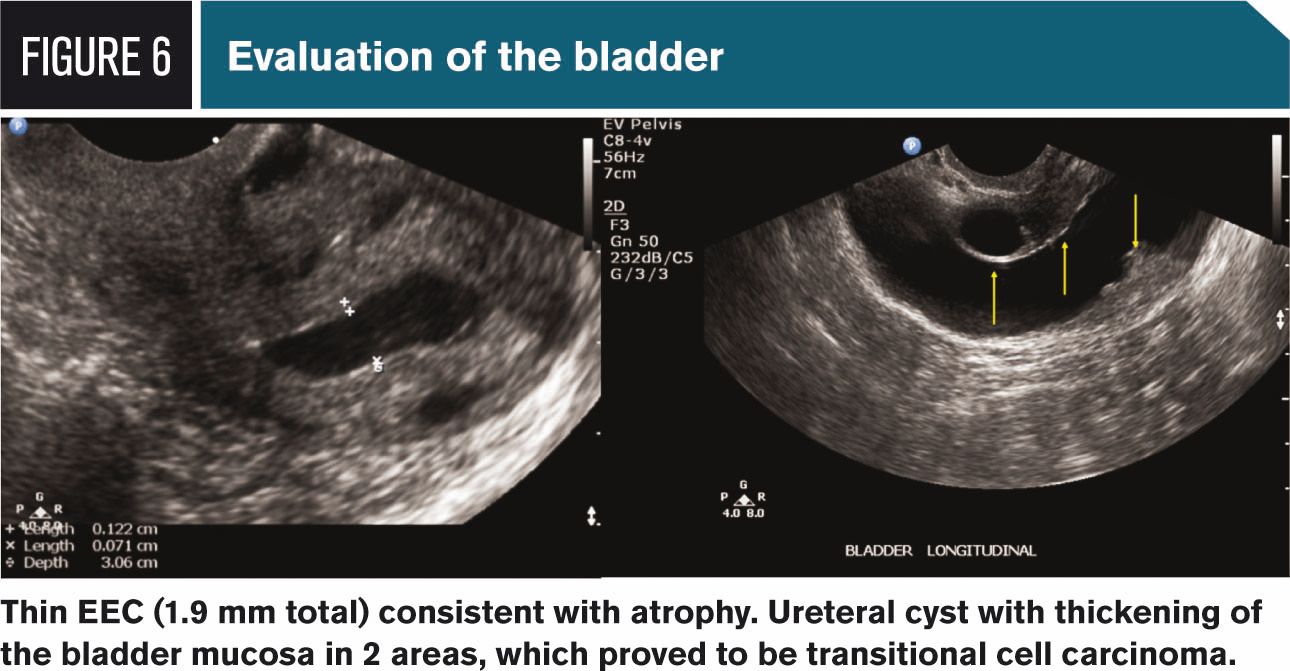

Technique
A complete TVS exam should be performed prior to SIS. This allows assessment of the uterine orientation and evaluation of the adnexa and bladder. SIS is indicated in patients with an indistinct or thickened endometrium, or in those with suspected focal lesions on TVS. The cervix is visualized and prepped with a suitable antiseptic solution, eg, povidone-iodine or chlorhexidine gluconate solution, prior to insertion of the catheter.
Many suitable catheters are available. If there is a small cervical opening, a Shepherd insemination catheter is helpful because it has a 5.4 F diameter with a small hollow stylet within the catheter. The stylet is rigid and allows molding of the catheter to the curve of the uterine cavity. A balloon catheter is helpful in the presence of a patulous cervix or large fibroids. The catheter enhances distension and improves SIS image quality in most cases. Finally, if an endometrial biopsy is anticipated, specifically designed catheters such as a Goldstein SonoBiopsy catheter or a Bernard catheter can be used for both saline infusion and subsequent biopsy, facilitating one-step in-office evaluation.
Attach a 10-mL syringe filled with saline to the catheter and flush prior to insertion to prevent air from entering the cavity and causing image distortion. If the Goldstein SonoBiopsy catheter is being used, the pyramidal “stopper” should be adjusted to approximately 1/2 cm less than the measured length from the external os to the fundus. This avoids penetrating the fundus with the catheter, while the stopper retards backflow of fluid from the cervix. If using a balloon catheter, fill the balloon with saline to avoid acoustic distortion. Prep the cervix with an appropriate disinfecting solution, locate the catheter within the endometrial cavity, and remove the speculum, being careful to avoid pinching the cervix. The 10-mL syringe allows the catheter and syringe to pass through the opening of a traditional speculum, thus negating the need for an open-sided speculum.
Replace the transducer in the vagina and infuse saline under direct U/S visualization. Take images in the longitudinal and transverse views. If 3D is available, a sweep in the longitudinal plan is often the only image required to reconstruct and measure the endometrium and identify any focal lesions. Retained fluid should be withdrawn by drawing back on the syringe plunger. Advise the patient to anticipate a watery discharge for several days following the procedure.
Patients tend to experience mild discomfort during specific maneuvers: traversing the internal cervical os, touching the fundus with the catheter, expanding the balloon (usually 11/2 mL is sufficient), rapidly distending the cavity, and performing a biopsy. Thus, advise the patient accordingly during these times, avoid touching or penetrating the fundus, and expand the balloon slowly. The discomfort experienced during sonobiopsy (an endometrial biopsy performed with the SIS catheter) is similar to or less than during a suction-piston endometrial biopsy.
Summary
TVS for initial triage of PMB identifies patients who do not need further endometrial evaluation at the initial visit, ie, those whose EEC is well-visualized and <4 mm thick. The risk of underlying cancer in these patients is quite low (1/917). TVS offers the additional advantage of evaluating the adnexa and the bladder. If the endometrium is >4 mm thick, proceed to SIS or tissue sampling. SIS allows reliable detection of focal intracavitary lesions, such as endometrial polyps or submucous myomas. Patients with thickened, asymmetric, or irregular EEC should undergo endometrial sampling following SIS.
Patients with focal intracavitary lesions should be triaged to surgical removal. Management of the remaining patients is based on endometrial biopsy results. If endometrial biopsy is not performed initially and a patient has recurrent bleeding, SIS and endometrial biopsy should be performed, with surgical treatment as indicated. TVS, followed by SIS when indicated, allows prompt in-office evaluation of patients with PMB, offering a reliable assessment of endometrial pathology, while minimizing cost and inconvenience to the patient.
References
1. American Cancer Society. What are the key statistics about endometrial cancer? www.cancer.org/cancer/endometrialcancer/ detailedguide/endometrial-uterine-cancer-keystatistics. Accessed April 30, 2014.
2. Goldstein RB, Bree RL, Benacerraf BR, et al. Evaluation of the woman with postmenopausal bleeding: Society of Radiologists in Ultrasound- Sponsored Consensus Conference Statement. J Ultrasound Med. 2001;20(10)1025–1036.
3. Smith-Bindman R, Kerlikowske K, Feldstein VA, et al. Endovaginal ultrasound to exclude endometrial cancer and other endometrial abnormalities. JAMA. 1998;280(17):1510–1517.
4. Goldstein SR. Modern evaluation of the endometrium. Obstet Gynecol. 2010;116(1):168– 176.
5. Goldstein SR. The role of transvaginal ultrasound or endometrial biopsy in the evaluation of the menopausal endometrium. Am J Obstet Gynecol. 2009;201(1):5–11.
6. Guido RS, Kanbour-Shakir A, Rulin MC, Christopherson WA. Pipelle endometrial sampling. Sensitivity in the detection of endometrial cancer. J Reprod Med. 1995;40(8):553–555.
7. Stovall TG, Photopulos GJ, Poston WM, Ling FW, Sandles LG. Pipelle endometrial sampling in patients with known endometrial carcinoma. Obstet Gynecol. 1991;77(6):954–956.
8. Rodriguez GC, Yaqub N, King ME. A comparison of the Pipelle device and the Vabra aspirator as measured by endometrial denudation in hysterectomy specimens: the Pipelle device samples significantly less of the endometrial surface than the Vabra aspirator. Am J Obstet Gynecol. 1993;168(1 Pt 1):55–59.
9. Dijkhuizen FP, Mol BW, Brölmann HA, Heintz AP. The accuracy of endometrial sampling in the diagnosis of patients with endometrial carcinoma and hyperplasia. Cancer. 2000;89(8):1765– 1772.
10. Farrell T, Jones N, Owen P, Baird A. The significance of an “insufficient” Pipelle sample in the investigation of post-menopausal bleeding. Acta Obstet Gynecol Scand 1999;78(9):810– 812.
11. Goldstein SR, Nachtigall M, Snyder JR, Nachtigall L. Endometrial assessment by vaginal ultrasonography before endometrial sampling in patients with postmenopausal bleeding. Am J Obstet Gynecol. 1990(1 Pt 1);163:119–123.
12. Granberg S, Wikland M, Karlsson B, Norström A, Friberg LG. Endometrial thickness as measured by endovaginal ultrasonography for identifying endometrial abnormality. Am J Obstet Gynecol. 1991(1 Pt 1);164:47–52.
13. Gupta JK, Chien PF, Voit D, Clark TJ, Khan KS. Ultrasonographic endometrial thickness for diagnosing endometrial pathology in women with postmenopausal bleeding: a meta-analysis. Acta Obstet Gynecol Scand. 2002;81(9):799–816.
14. Timmermans A, Opmeer BC, Khan KS, et al. Endometrial thickness measurement for detecting endometrial cancer in women with postmenopausal bleeding: A systematic review and meta-analysis. Obstet Gynecol. 2010;116(1):160–167.
15. Chandavarkar U, Kuperman JM, Muderspach LI, Opper N, Felix JC, Roman L. Endometrial echo complex thickness in postmenopausal endometrial cancer. Gynecol Oncol. 2013;131(1):109–112.
16. American College of Obstetricians and Gynecologists. Committee Opinion No. 426: The role of transvaginal ultrasonography in the evaluation of postmenopausal bleeding. Obstet Gynecol. 2009;113(2 Pt 1):462–464.
17. Gull B, Karlsson B, Milsom I, Granberg S. Can ultrasound replace dilation and curettage? A longitudinal evaluation of postmenopausal bleeding and transvaginal sonographic measurement of the endometrium as predictors of endometrial cancer. Am J Obstet Gynecol. 2003;188(2):401–408.
18. Goldstein SR. Use of ultrasonohysterography for triage of perimenopausal patients with unexplained uterine bleeding. Am J Obstet Gynecol. 1994;170(2):565–570.
19. Carlson JA Jr, Arger P, Thompson S, Carlson EJ. Clinical and pathological correlation of endometrial cavity fluid detected by ultrasound in the postmenopausal patient. Obstet Gynecol. 1991;77(1):119–123.
20. Debby A, Malinger G, Glezerman M, Golan A. Intra-uterine fluid collection in postmenopausal women with cervical stenosis. Maturitas. 2006;55(4):334–337.
21. Goldstein SR. Postmenopausal endometrial fluid collections revised: Look at the doughnut rather than the hole. Obstet Gynecol. 1994;83(5 Pt 1):738–740.
22. Amit A, Weiner Z, Ganem N, et al. The diagnostic value of power Doppler measurements in the endometrium of women with postmenopausal bleeding. Gynecol Oncol. 2000;77(2):243–247.
23. Dijkhuizen FP, Mol BW, Brölmann HAM, Heintz AP. Cost-effectiveness of the use of transvaginal sonography in the evaluation of postmenopausal bleeding. Maturitas. 2003;45(4):275–282.
24. Weber AM, Belinson JL, Bradley LD, Piedmonte MR. Vaginal ultrasonography versus endometrial biopsy in women with postmenopausal bleeding. Am J Obstet Gynecol. 1997;177(4):924–929.
25. Gupta JK, Wilson S, Desai P, Hau C. How should we investigate women with postmenopausal bleeding? Acta Obstet Gynecol Scand. 1996;75(5):475–479.
26. Wang J, Wieslander C, Hansen G, Cass I, Vasilev S, Holschneider CH. Thin endometrial echo complex on ultrasound does not reliably exclude type 2 endometrial cancers. Gynecol Oncol. 2006;101(1):120–125.
27. Hosoi A, Ueda Y, Shindo M, et al. Endometrial thickness measured by ultrasonography in postmenopausal patients with endometrial carcinoma has significance, irrespective of histological subtype. Int J Gynecol Cancer. 2013;23(7):1266–1269.
28. Epstein E, Ramirez A, Skoog L, Valentin L. Transvaginal sonography, saline contrast sonohysterography and hysteroscopy for the investigation of women with postmenopausal bleeding and endometrium > 5 mm. Ultrasound Obstet Gynecol. 2001;18(2):157–162.
S4E1: New RNA platform can predict pregnancy complications
February 11th 2022In this episode of Pap Talk, Contemporary OB/GYN® sat down with Maneesh Jain, CEO of Mirvie, and Michal Elovitz, MD, chief medical advisor at Mirvie, a new RNA platform that is able to predict pregnancy complications by revealing the biology of each pregnancy. They discussed recently published data regarding the platform's ability to predict preeclampsia and preterm birth.
Listen
